| 8 easy things to remember… |
I wrote this guide to provide business partners with thoughts on an easy and efficient way to engage their technology partners. It’s not always easy to embrace technology as it can be rather complex, my aim was to provide a simple guide to working with technology in order to drive project success. Although the post is long, I’m hoping that you find it useful and will share it with others.
| A blog for success by Richard Kottke |
 |
| Business to Technology Engagement History |

| Just as there are several ways to manage a project, there are many ways to engage in technical projects.
In the early to mid 20th century the modern computer was developed. This gave us the advantage of a computational machine that would complete business related tasks in a fraction of the time that it took a human resource to complete. At nearly the same time, computer science related project management became recognized as a discipline instead of the ad-hoc process of managing projects through a scheduled number of tasks.
Prior to this time, formal technology engagement was virtually non-existent. An assigned business lead would reach out directly to the technologist and provide them with spec’s on what was to be built. Most of the time the Research and Development group fulfilled the role of the technology group. There were no PC’s at that time and most main frame computers were leased from the major computer manufacturers or universities. |
| As the costs and size of computers came down, the need for project manager engagement with technology began to rise. Organizations discovered the numerous reporting capabilities of systems and requested technical projects from these systems. However, the engagement was undisciplined and unruly causing many delays and setbacks in project completion. |
History of Advanced Computing Technology
Advanced Computing Technology – starts with the evolution of computing machines and software
| Although there are several methodologies, programming languages, and hardware not included in the above timeline, the items listed have had a significant impact on today’s technological advances. With the innovation of the of the modern computer (CPU, memory, and peripherals), technology has moved forward in an unprecedented pace. |
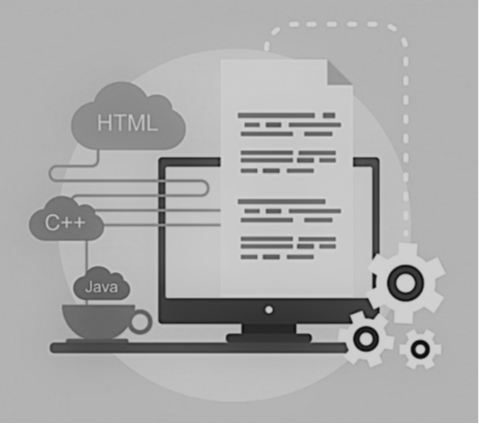 |
| Technology has the ability to meet business needs at a much faster pace than it did in past. However, the ability to harness that power has been a challenge over the last 60+ years. Machines don’t speak a “human” language, nor do they comprehend human abstract thought. Thus, we rely on human technologists to explain/relay human thoughts to technology. The problem with that is we are all individuals and have unique ideas on how things should work. Applications developed through technology must be carefully planned in order to deliver expected results. Some of this is seen through the business use of methods that were developed specifically for building software applications, i.e. – Waterfall, Spiral, RAD, and Agile methods. Although these methods have their origins in software development, they have become ingrained in project management and are frequently discussed with business partners to ensure that the business receives expected product. |
Technology
| Through the 50’s to 70’s the need for a separate Technology team for the average to large company was rare. The equipment was expensive and the technologist were specialized and limited in ability. The existence of business administrative applications were also limited and those that did exist were mainly financial in nature. Because of these limitations, the technology teams that existed were managed and reported to the finance department. |
| The need for technical teams within an organization came about with the mass production of smaller hardware, faster software, the creation of online/mobile applications, and the ability of computers to perform complex tasks. |
With the rise of modern computing systems, leadership redefined their organizations similar to the image below. Several new departments were created to handle the technical needs.
In most current environments, these departments don’t report to business management. This would suggest that these resources are viewed as performing a separate function within the organization and thus work under a separate agenda. This may differ from the businesses itinerary. |
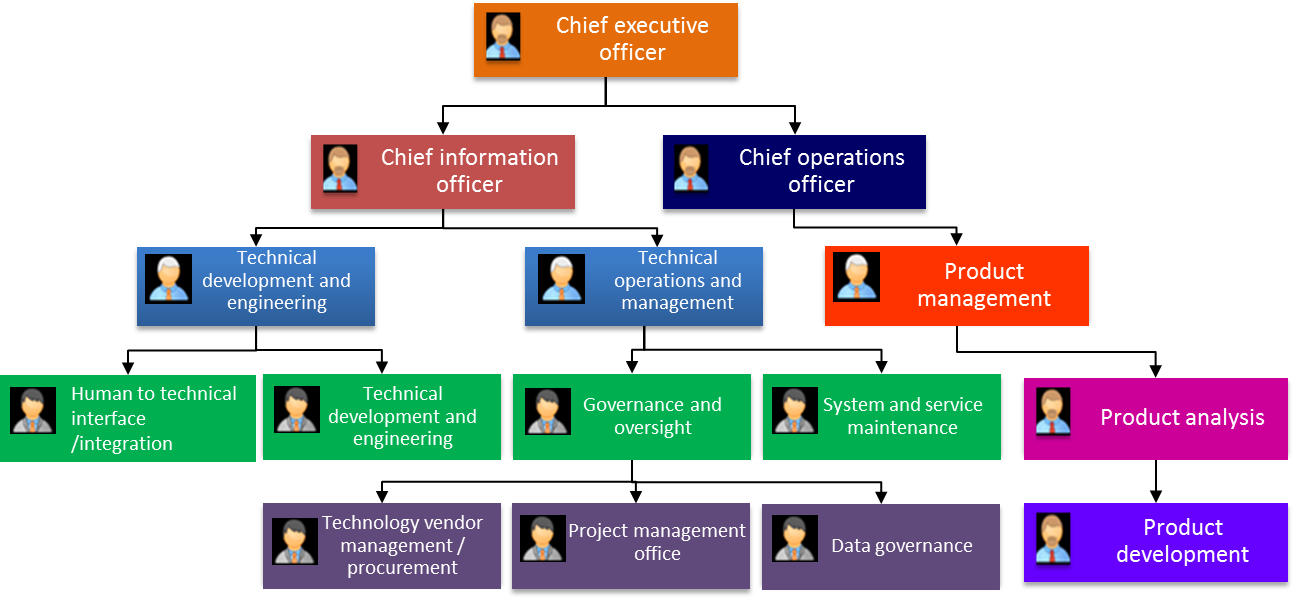
Business, Technology, and Others…
| Technology has a symbiotic relationship with other parts of an organization. It must work hand-in-hand with others to complete finished products. |
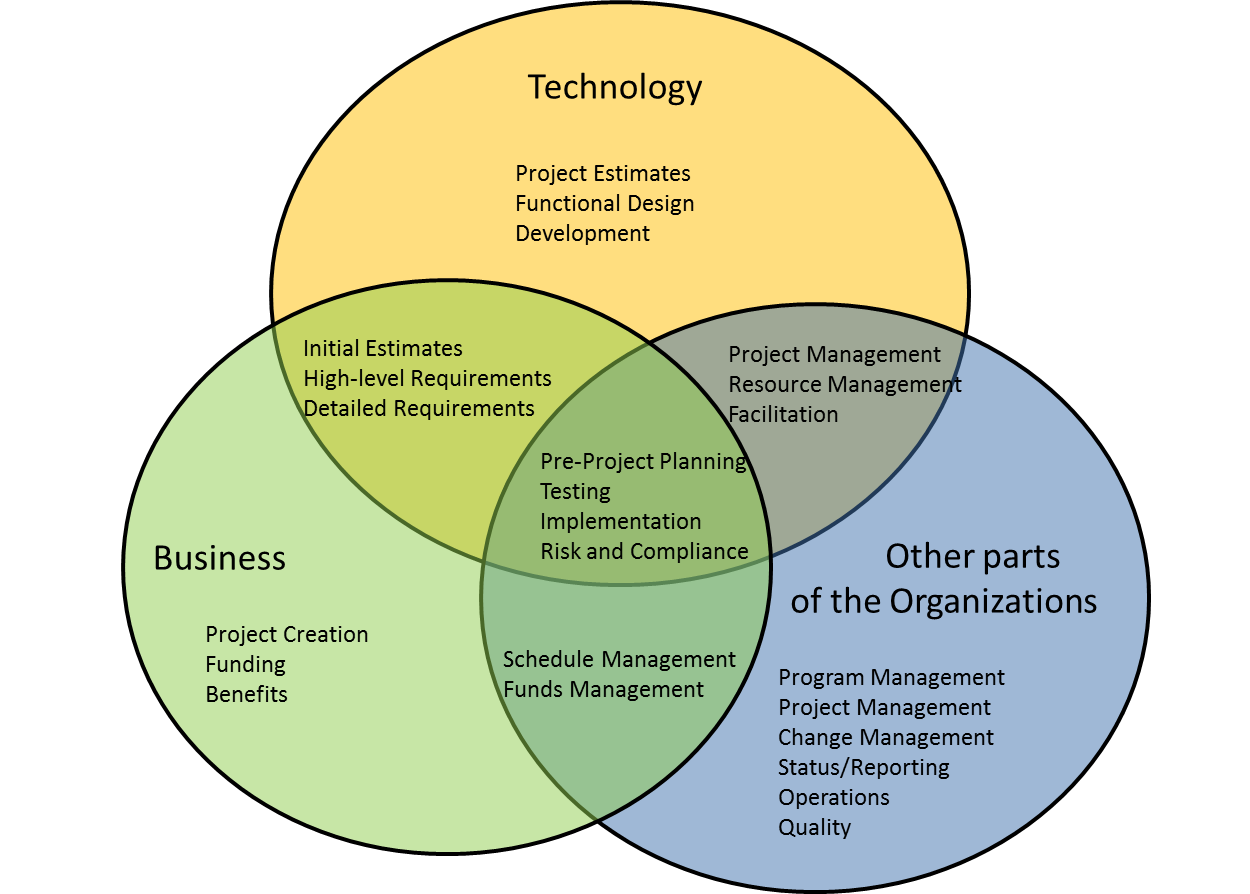 |
- Technology is responsible for producing products based on Business specifications.
- The Business is responsible for creating products that meet the organization’s objectives.
- Other parts of the organization are responsible for the guidelines and quality that are used to manage technology and confirm a quality product
|
Easy things to remember when working with Technology
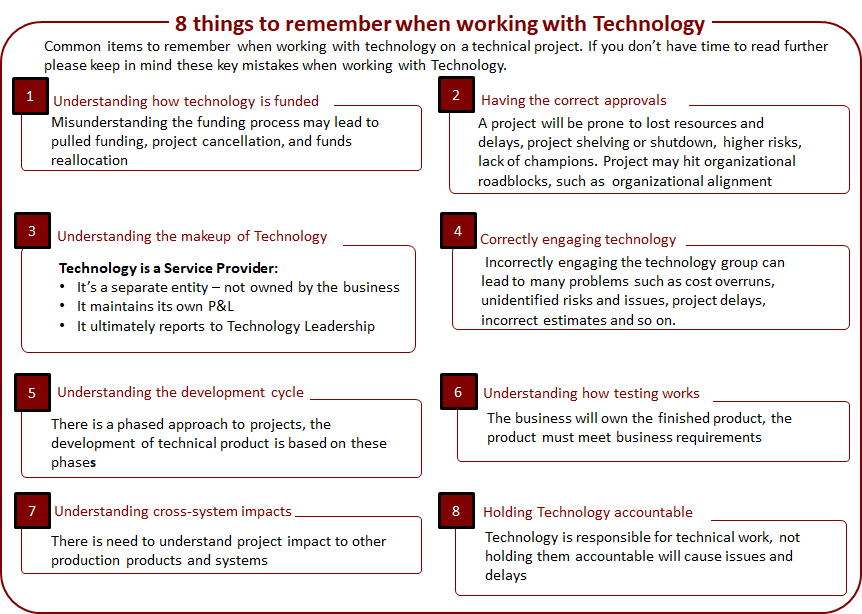 |

| The organizational funding process can be complex as it involves the entire organization. Since it is organization wide, the funding request from each group differs and may lead to disorder between the groups looking for funds. This misalignment usually causes a number of problems for both the business and technology groups, examples of these ‘direct impact’ issues are listed to the right. |
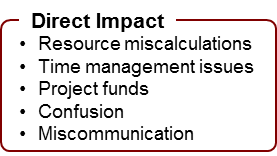 |
| Projects are expensive, not having startup funds to investigate, the time-frame, requirements, and resources to develop a new product can lead to problems. The business would like to create new products that not only meet customer needs, but follow the organizations direction and turn a profit for the organization. In order to realize the project’s cost benefit, there is a need for a high-level estimate of what the product will cost to build and get into production. There may be a thought that the tech partners will provide such a high-level estimate for free, that is not always the case.
Why, because in most cases technology is considered a profit center. This means that the business will need a cost center to bill tech project work, this includes providing high level estimates. If the project has a technical component, the business team will need to engage technology to get an initial project cost estimate. |
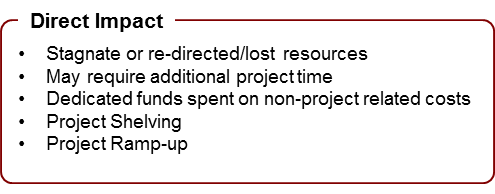 |

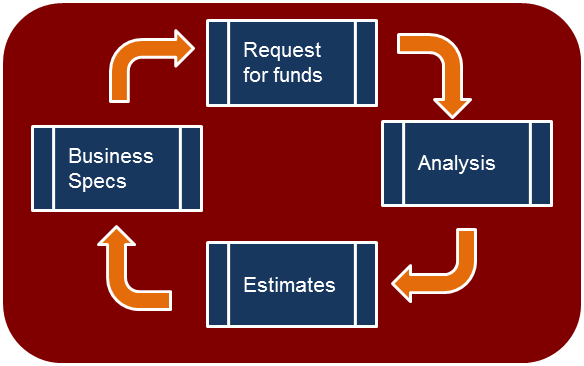 |
The lack of required project approvals will slow down if not stop project work. Without these approvals, in most cases the project will be doomed for lack of support from stakeholders within the organization. |
| It is key to ensure that those stakeholders impacted by the project support the project. Stakeholders that have a perception the project will negatively impact their world must be notified of the project. They must have a good understanding of how the project will benefit them and the organization. Without stakeholder buy-in, the project is likely to fail. Getting approval up front will aid in project support, even from the nay-sayers. |
 |
The usual required approvals:
- Business case and benefits
- Stakeholder approval
- Funding
- Risks, issues, and changes
- Project Charter – PM authority to work on the project
- Governance Document – project resources
- Project Management Plan
|
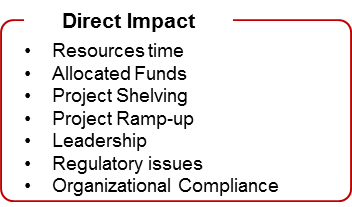 |

| In order to succeed, Technology must work with all parts of an organization. However, as part of that success it must not be tied directly to one specific part of the business. Technology must manage it’s own resources independently to be successful. It shouldn’t be aligned directly with others. |
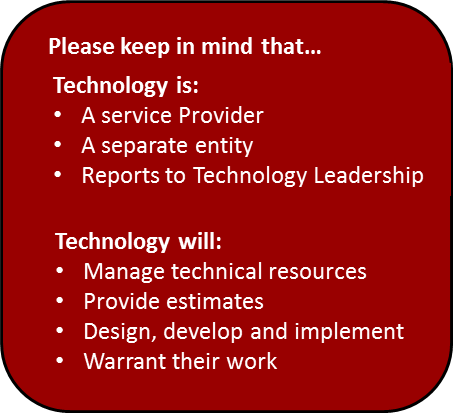 |
| Technology uses a complex series of actions and steps to build product. This process has at least five phases and is used as the foundation to successfully meet customer’s requirements. The process includes steps for initiating, planning, designing, estimating, developing, managing, testing, and delivering the final expect product. The process is used to control project budget, risks, issues, resources, and communication. |
 |

| Incorrectly engaging the technology group can lead to many problems such as cost overruns, unidentified risks and issues, project delays, incorrect estimates and so on. |
| Engaging Technology too early can lead to scope creep, funding issues, time delay and additional project costs. You may encounter project bias, early project spend, unneeded resourcing, and unwanted features. |
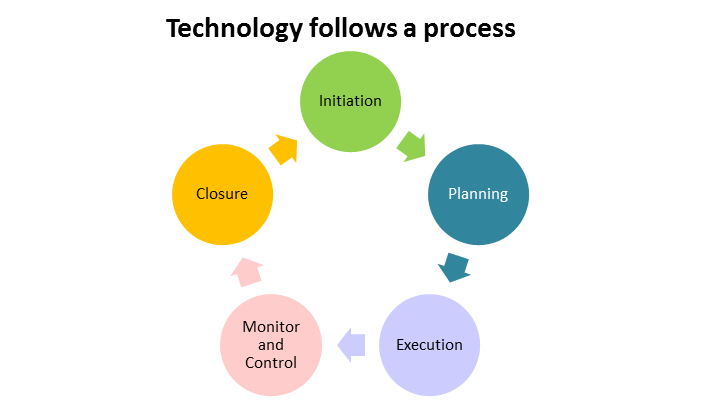 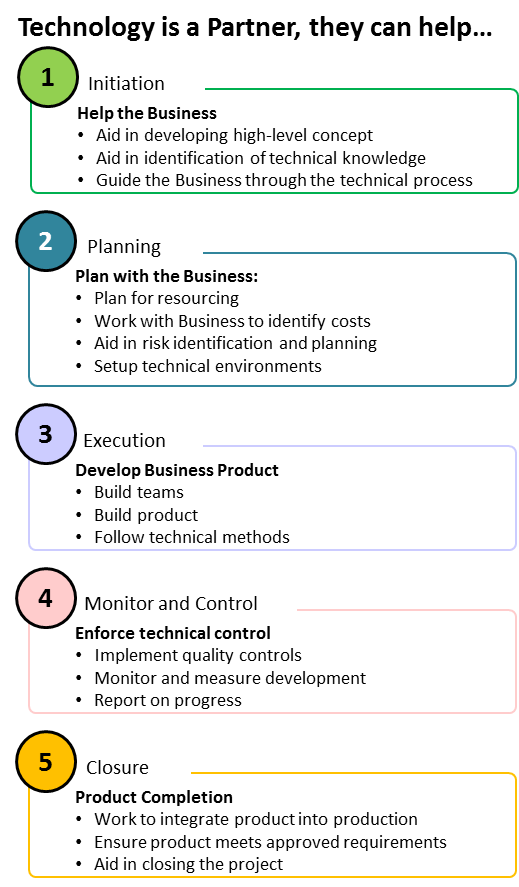 |
| Business product managers spend a lot of time researching and developing the right product. The product analysis should be complete prior to engaging technology. Allowing technical influences at this time would cause a deviation from the planned product.
Direct impacts to the product/project would include:
- Additional Time
- Stagnate or additional resources
- Monies spent on non-project work
If engaged too early in the process, Technology partners may want to impose their thoughts on the finished product. This is not within their realm and can lead to a product that is not usable in the market… |
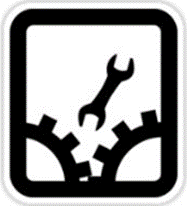 |

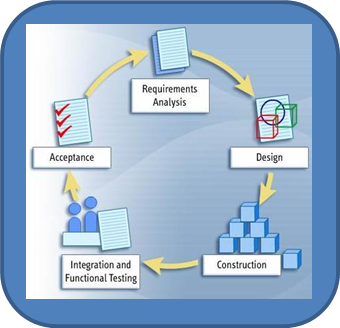 |
SDLC is a process for working through the development of a new product.
- The process starts with an initiation phase to confirm requirements and to get ready for design
- Once design is complete, development or the build phase begins
- After development is confirmed to be complete the project moves to the testing
- This is where the Business will do UAT testing and approve the project to move forward into production
- The final piece is approval and acceptance of the completed product.
- Once approved, the product moves to production and the team moves on to the next technical project
|
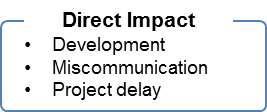 |

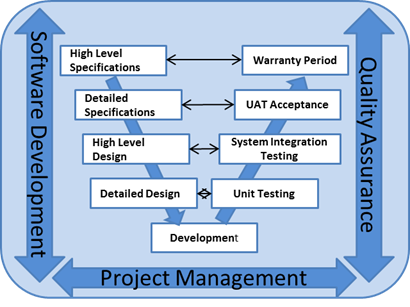 |
In past years, technology would perform testing. This included such groups that supported the testing effort. In modern times, testing is managed by test management. This team is responsible for testing the product to ensure the final product meets approved requirements.
Testing Management – the Technology PM works with the testing management team to assign a Test Manager. The Test Manager provides the Test Management Plan.
Test Managers – Test Managers create the test schedule, review the plan and schedule with the project team, and obtain test planning approvals. Once approved, the testing team will move on to building test cases that tie back to requirements.
Project Testing – Testing is usually broken down into testing types such as:
- Unit Testing – Testing done during development
- System Integration Testing – a testing process to test coexistence with other apps or systems
- User Acceptance testing – UAT is the last performed testing prior to acceptance. The results are usually used to secure product acceptance and approval
|

| Developing and implementing new products may have a direct impact on the current organization systems. Depending on the product, the impact can be so great as to impede existing organizational products in production and lead to higher than expected errors and defects. The Test Manager or Project team should have a plan to manage and control cross system project impacts, most larger organizations have a separate group that manages the cross-system impacts.
Business partners may be unaware of a department within the organization known as Release Management. Release Management is the team that identifies, manages, and controls project implementation as well as cross-system impacts. Without this type of management, a project may impact another organizational system in such a way as to cause it to fail. Obviously, this would have a negative impact to the organization and needs to be avoided. |
The RMO:
- Monitors and controls all implementation activities
- Confirms System Cross Dependencies
- Plans and Schedules release work on a yearly basis
|
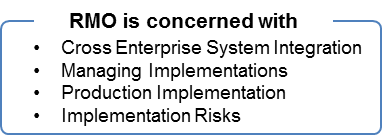 |

 |
The inability to hold your technology accountable for their work will cause project delivery issues.
Impacts include:
- Missed deadlines
- Delays
- Rising costs
- Unclear expectation
- Additional risks
- Unclear design
- Not getting the product you want.
Keep in mind, your Technology Partners are there to help you. |
| Questions?
If you have any questions, need clarification, or want to learn more…
Contact your IT Director or Program Manager if you have any questions about working with Technology. These resources can aid in pulling in other technological groups (the PMO, Technology, Leadership) as required. |































